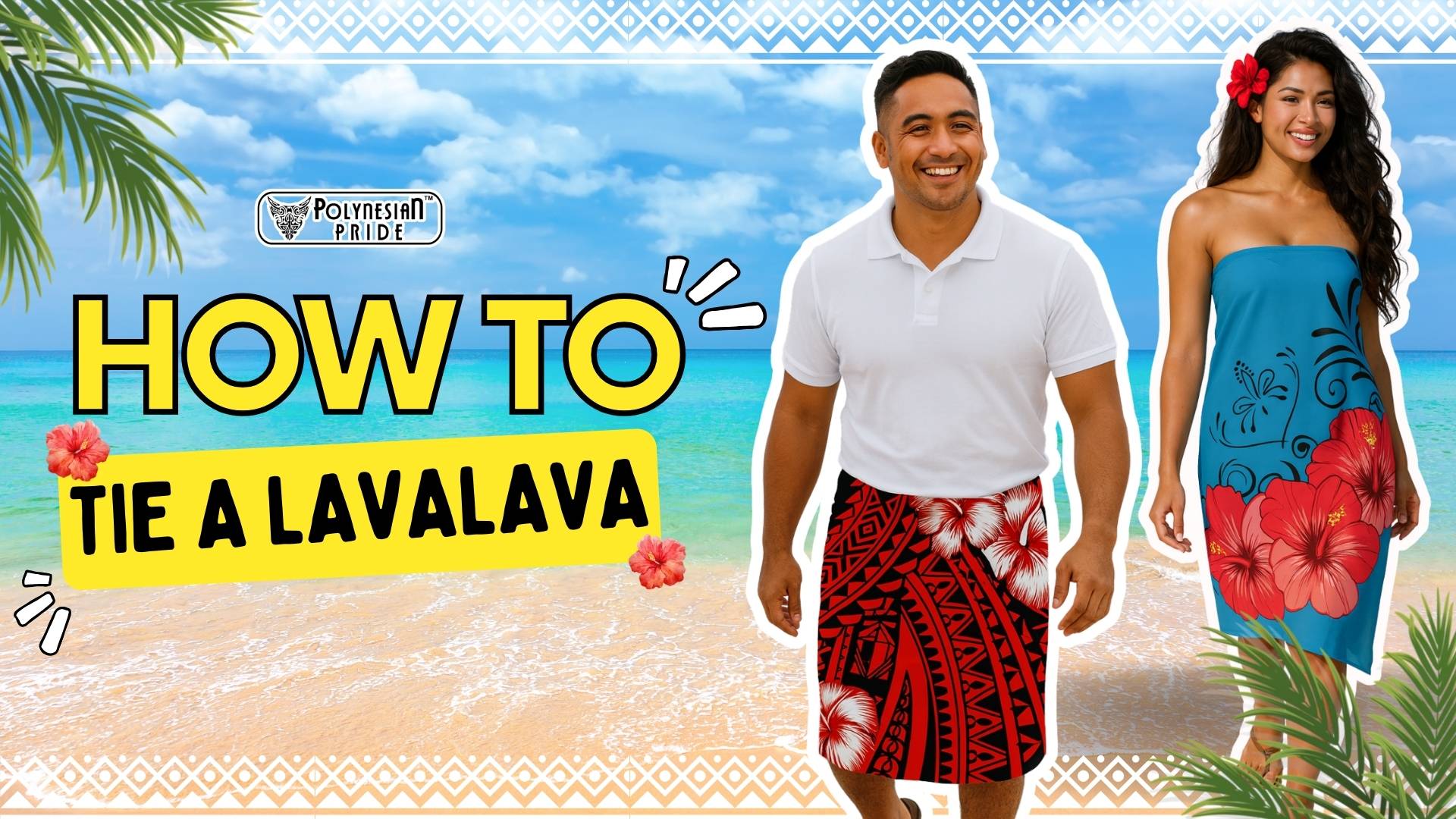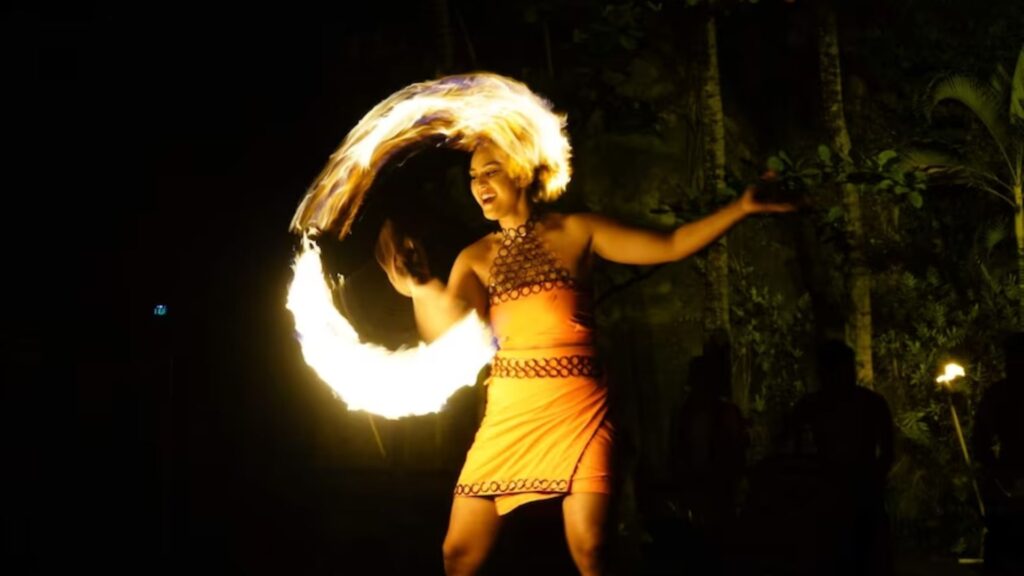How to Tie Lavalava: Men’s & Women’s Step-by-Step Guide

The lavalava is a symbol of identity and a practical garment loved across Polynesia. Learn how to tie lavalava for men and women on any occasion!
What Is a Lavalava?
A lavalava or ie lavalava is a rectangular piece of cloth traditionally worn in Samoa and other parts of Polynesia and Melanesia, like Tonga, Hawaii, and Fiji. Both men and women wear it for daily life, ceremonies, church, school, and special occasions.
The lavalava plays an important part in cultural identity in Polynesian clothing.
Lava Lava Vs Sarong?
While often compared to a sarong or pareo, the lavalava has distinct cultural significance.
In the context of lava lava vs sarong, the lavalava is deeply rooted in Polynesian identity and ceremonial use, while the sarong is more widely worn across Southeast Asia and often refers more generally to a “wrap skirt” worldwide.
When to Wear a Lavalava?
In Pasifika countries, the lavalava blends cultural significance with everyday function.
- Casual: Everyday wear around the village, beach days, or lounging at home.
- Formal: Paired with a dress shirt for men or a blouse for women at church, weddings, or official events.
- Cultural Events: Worn proudly as a sign of heritage and respect.
Pro Tip: Always make sure your lavalava is tied securely, especially during active occasions like dancing or sports.
How to Tie Lavalava for Men
If you’re searching for practical instructions on how to tie a lavalava for guys, you’re in the right place.
This guide breaks down the best styles of lavalava tying for beginners, from casual daily wear to formal events and traditional dance.
For Daily Wear
Suitable Lavalava Style:
- Fabric: Lightweight cotton, rayon, or polyester that is ideal for comfort in tropical weather.
- Colors & Patterns: Bold, lively prints such as florals, tapa (siapo), tribal motifs. Express cultural pride with vibrant designs.
- Length: Falls mid‑calf to just below the knee for ease and modesty.
Step‑by‑Step Tying Guide (Twist & Tuck Method):
- Hold the lavalava behind your waist; align the top edge comfortably.
- Adjust the length to mid‑calf or just below the knee.
- Bring the two ends to the front and gather them together.
- Twist the ends tightly 2–3 times to create tension.
- Drop one end and tuck the other into the inner waistband securely.
- Smooth the front panel and test with a small step and tighten if necessary.
For Formal Occasions (Ie Faitaga / Solid Colors)
Suitable Lavalava Style:
- Fabric: Tailored linen or suiting-weight poly-cotton blends for structure.
- Colors & Designs: Solid dark tones like black, navy, forest green, or white for church, village meetings, or ceremonies.
- Length & Features: Mid‑calf with clean hems; may include pockets and ties/buckles – this is the traditional ‘ie faitaga style.
Step‑by‑Step Tying Guide (Flat Front Formal Style):
- Wrap the lavalava around your waist, ensuring the front panel is flat and the hem is even.
- Overlap the right panel over the left with a generous coverage.
- If the ‘ie faitaga has ties or a buckle, secure it neatly at the hip.
- For plain wraps, tie a small square knot at the front-right hip and tuck the ends inside for a clean finish.
- Ensure the fabric lies smoothly and the fit is secure and dignified.
For Dancing (Short & Bold)
Suitable Lavalava Style:
- Fabric & Length: Shorter wraps that fall above the knee for freedom of movement during performance, such as fire knife or traditional dances.
- Colors & Designs: Bright, loud prints such as sequins, satin, velvet, or polyester for visual impact and stage presence.
Step‑by‑Step Tying Guide (Secure for Movement):
- Wear the lavalava just above the knee for better movement.
- Tightly wrap the two ends around your waist.
- Twist the ends tightly 2–3 times to create friction and tension.
- Tuck one end and optionally add a small knot or clip for extra hold.
- Test movement with light dancing steps; adjust tightness as needed.
Quick Comparison Table
| Occasion | Fabric & Design | Length | Tying Method |
| Daily Wear | Lightweight, vibrant prints | Mid-calf/knee | Twist & tuck with a simple knot |
| Formal Occasion | Linen/poly‑cotton, solid dark colors, refined | Mid‑calf | Flat front, ties or tuck, neat look |
| Dancing | Bright synthetics, bold patterns | Above knee | Twist, tuck, knot/clip for security |
With the right fabric, fit, and tying method, your lavalava becomes both practical and meaningful, ready for any occasion.
How to Wear a Lavalava for Women
When it comes to styling women’s lavalava clothing, the beauty lies in its versatility. From everyday comfort to ceremonial elegance and performance-ready wraps, here’s how to tie it based on the occasion.
For Daily Wear
Best Style Choices:
- Fabric: Lightweight cotton, rayon, or breathable polyester that is perfect for tropical climates and everyday comfort.
- Colors & Patterns: Bright florals, ocean-inspired blues, traditional siapo/tapa prints, and bold Polynesian motifs.
- Length: Typically ankle-length for comfort and modesty in daily settings.
Step-by-Step Tying Guide:
- Hold the lavalava behind your waist and align the top edge.
- Adjust to be ankle-length for daily wear.
- Bring both ends to the front; overlap left, then right.
- Wrap the fabric closest to you with the loose end twice.
- Tuck in the wrapped ends securely.
- Smooth the front panel and ensure it sits comfortably and securely.
For Formal Occasions (e.g., Church, Weddings)
Best Style Choices:
- Garments: The puletasi (a two-piece outfit: top + wrap skirt) is the traditional female formal attire in Polynesia. It often incorporates the lavalava-style skirt paired with a matching blouse.
- Fabric & Design: Formal lavalavas are made of structured materials like silk, thicker cotton, or poly blends, often embellished with elegant tapa accents or embroidery.
- Length & Features: Ankle-length with intricate details; the overall outfit is polished and conservative in color and style.
Step-by-Step Tying Guide:
- Wear the lavalava as part of your puletasi set. Begin by wrapping the skirt with the top fitted over it.
- Align the front for a smooth appearance.
- Wrap the left panel over the right with generous coverage.
- Tuck or use side ties for a secure fit; ensure the wrap lies flat.
- Pair with a matching blouse/button-up top for a graceful finish.

For Dancing
Best Style Choices:
- Fabric & Length: Shorter lavalavas with above-the-knee length are to allow maximum mobility. Often made from lightweight synthetics or light cotton.
- Colors & Design: Eye-catching, bold prints with vivid colors enhance movement visibility on stage.
Step-by-Step Tying Guide:
- Adjust the lavalava to a shorter length (above the knee) for dynamic moves.
- Wrap tightly around the waist.
- Twist the ends a couple of times for a strong hold.
- Tuck in one end; optionally knot or secure with a clip.
- Move through a few dance steps (e.g., siva or fa’ataupati); retighten as needed for motion confidence.

Quick Reference Table for Women
| Occasion | Fabric & Design | Length | Tying Method & Features |
| Daily Wear | Light cotton/rayon, lively prints | Ankle-length | Left-over-right wrap, wrap twice, tuck tightly |
| Formal Occasion | Structured fabrics, embroidered or tapa details | Ankle-length | Wrapped flat, tucked or tied, paired with a blouse |
| Dancing | Lightweight synthetics, vivid prints | Above the knee | Twist, tuck/knot, ensure secure for active movement |
A well-tied lavalava not only looks beautiful but also honors tradition. By selecting the right style for each moment, you express both confidence and cultural pride.
Where to Shop for Good Lavalava?
At Polynesian Pride Shop, we create contemporary lavalavas that honor Polynesian culture while meeting today’s lifestyle needs.
✅ Premium fabric: 100% wrinkle-free polyester that’s breathable, lightweight, and durable that perfect for hot climates or traveling far.
✅ Vibrant designs: From classic Polynesian motifs to modern tropical prints, each piece reflects cultural pride.
✅ Inclusive fit: Thoughtfully sized to let you style your lavalava in multiple ways.
- Men’s lavalavas come in sizes S to 7XL, fitting waists from 82–112cm and lengths from 60–80cm.
- Women’s lavalavas measure 66 inches x 44 inches, that ideal for wearing as a skirt, dress, top, shawl, beach towel, or even a picnic throw.
✅ Great service: Our team is ready 24/24 to help you choose the perfect design, style, or customize your own piece.
✅ Customer satisfaction: 100% refund or exchange if your item has any defect or you’re not completely happy.
✨ Whether you’re heading to the islands, celebrating your heritage, or looking for stylish, cultural clothing, Polynesian Pride lavalavas are made for comfort, confidence, and connection.
👉 Explore our Lavalava Collection and find your perfect fit now!
Wrap up
Learning how to tie lavalava is more than just mastering a style; it’s embracing a piece of Polynesian culture. Whether worn casually, at a ceremony, or as a creative accessory, the lavalava is timeless and multifunctional.
Celebrate tradition with style by exploring Polynesian Pride’s lavalava collection and finding the perfect piece that connects culture with modern design.
FAQs about How to tie Lavalava
What does ie lavalava meaning?
The term ie lavalava comes from the Samoan language – “ie” means cloth and “lavalava” means to wrap. Together, it refers to a traditional Polynesian wrap skirt used for both everyday and ceremonial wear.
What to wear under a lavalava?
Lavalavas are usually worn over underwear. Men often wear briefs or shorts underneath, especially for movement or modesty. Women may choose to wear slips, shorts, or swimwear depending on the setting and lavalava fabric.
What is the difference between a lavalava vs sarong?
While both are wrap garments, a lavalava is specific to Polynesian culture, which is particularly Samoan culture. A sarong is a more general term used in Southeast Asia and globally to describe various wrap skirts with less cultural specificity.
Can men and women both wear lavalavas?
Yes! Both men and women in Polynesia wear lavalavas, with slight differences in tying style.
What occasions are best for wearing a lavalava?
From casual everyday wear to formal cultural events, the lavalava fits all occasions.

I’m a lifestyle curator who has blended Polynesian foodways and fashion into everyday life for over five years. I celebrate makers, materials, and style—with heritage as the headline, not the footnote.
My contact:
Email: [email protected]
Tel: +689 87 246 367










